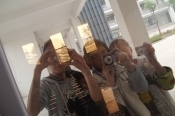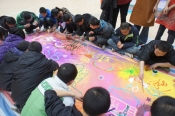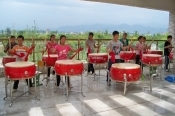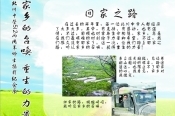By Zou Qiao, Programme Officer (Post-Disaster Reconstruction and Culture), Sichuan Programme, PCD
 Editor’s note: It has been five years since a mega earthquake hit Wenchuan in Sichuan in 2008. Unfortunately Sichuan was hit again when a magnitude-7 earthquake struck Lushan County of Ya’an Prefectural City this year. But since we have all gained experience of reconstruction work subsequent to a mega disaster, we anticipate that responses from people from all walks of life in the face of any new disaster will in future be more useful and effective. The focus of PCD’s work is to rouse people to a spiritual awareness and to see this as an important path to sustainable living. Because of this, PCD’s reconstruction programme after the earthquake of Wenchuan focused on alleviating the trauma of the people affected by the disaster and rebuilding a proactive community spirit. The approach adopted by the programme was “community arts” and made use of activities on this theme to rouse the inner strength of the people and facilitate a sense of solidarity among them. Our colleague, Zou Qiao, sums up PCD’s experience with workers engaged in post-disaster relief work, and looks back on how community arts came into play in reconstruction efforts and enabled people affected by the disaster to practice sustainable living as they set out again on their journeys through life.
Editor’s note: It has been five years since a mega earthquake hit Wenchuan in Sichuan in 2008. Unfortunately Sichuan was hit again when a magnitude-7 earthquake struck Lushan County of Ya’an Prefectural City this year. But since we have all gained experience of reconstruction work subsequent to a mega disaster, we anticipate that responses from people from all walks of life in the face of any new disaster will in future be more useful and effective. The focus of PCD’s work is to rouse people to a spiritual awareness and to see this as an important path to sustainable living. Because of this, PCD’s reconstruction programme after the earthquake of Wenchuan focused on alleviating the trauma of the people affected by the disaster and rebuilding a proactive community spirit. The approach adopted by the programme was “community arts” and made use of activities on this theme to rouse the inner strength of the people and facilitate a sense of solidarity among them. Our colleague, Zou Qiao, sums up PCD’s experience with workers engaged in post-disaster relief work, and looks back on how community arts came into play in reconstruction efforts and enabled people affected by the disaster to practice sustainable living as they set out again on their journeys through life.
This year is the fifth anniversary of the Wenchuan earthquake. Students and NGOs in Sichuan have held many commemorative activities to look back and summarise post-disaster reconstruction work as well as to provide lessons for reflection on reconstruction work after the earthquake in Lushan.
In one of our reconstruction programmes after the Wenchuan earthquake, PCD collaborated with Prof. Long Di of the Institute of Psychology of Chinese Academy of Sciences in organising activities on community arts for students of two secondary schools—Beichuan Secondary School and Yongchang Secondary School—to help them recover from the trauma and become active and energetic again. A while ago, I was invited by Prof. Long to take part in the “Second Forum on Psychological Health and A Harmonious Society in China—Summing Up the Experience of Wenchuan Earthquake and Promoting Psychological Relief Work in Lushan”. Since five students from Sichuan who had taken part in PCD’s programmes were sharing their experience on the forum, I was thrilled about meeting them and other PCD partners again.
Community Arts: Nurturing Solidarity and Culture of Non-violence
It was five years ago and Beichuan Secondary School had to be rebuilt soon after the earthquake. The school had to temporarily make use of rooms in Changhong Training Centre for classes when the new semester started after the earthquake. Near the centre there is a railway line, and trains often rumble by. The noise and the shaking made by the trains made it feel as if they were rolling over one’s heart, and enhanced the sense of being shattered and abandoned in many people after the earthquake. It was here that we met Prof. Long Di and her team as well as the students. A very deep impression that I gained at that time was how Prof. Long kept emphasising the need to grasp the context and respond to it appropriately. Beichuan Secondary School suffered many casualities. A third of its students, teachers and staff had been injured or had died in the earthquake. Everyone had lost someone very important to them,while many had needed amputations. At the school, there had always been some conflicts and tensions which worsened because of the earthquake. For this reason, from the very beginning, there was an important consensus in PCD’s programmes that our objective was to build a spirit of solidarity and to nurture a culture of non-violence. It was with such a background that we began our initiatives on community arts. This was not incidental but a necessity. In such a peculiar period of time, community arts could bring joy and peace while creating solidarity among all who were affected by the earthquake without them being aware of it.
At that time, Prof. Long invited people with different professional backgrounds to conduct different kinds of community arts activities for the students: painting, photography, dancing, handicraft, music, and so forth,each of which was attended by dozens to hundreds of students. Through these activities, interaction and solidarity among the students were enhanced and the support systems among friends and peers were strengthened. The pain caused by the earthquake gradually diminished.
The visual arts activities left a very deep impression on me. Prof. Long had invited experts in photography to show the students how to use a camera. A photography interest group was set up and the students were encouraged to photograph their villages and their school campus. They were then invited to talk about the stories of their villages and how they were rebuilt. A photographic exhibition entitled “The Call of the Home Village, The Power of Rebirth” was held on the second anniversary of the earthquake. I was touched by the photos and their captions. There were scenes of reconstruction in full swing as well as of everyday life in temporary shelters, such as washing and drying clothes in the sun, or flowers blossoming in the shelters. There were photos of parents and relatives who were labouring and close-ups of plants. These details of everyday life which seemed so ordinary became something different in the observation and writing of the students. They said:
“Where the houses had fallen a strength for rebirth was lit, to fight for our fiery days.”
“Grandma is 61 years old now. She is weeding! If I were a piece of pea growing vigorously and healthily, then Grandma would be the root which contributes its own effort in silence.”
“Standing at the corner I saw you labouring under the scorching sun. I believe firmly that our home and our village will be better than before.”
“The bottle gourd wraps itself round the pear tree. They are very different, yet they are able to grow together just like our community.”
……
I was moved by their love of their villages and families, but I was touched most of all by the wisdom and strength that they had gained from the land and from life and by the fact that they were able to express them with such strong feelings. The photographic exhibition became a starting point for sharing and listening to each others’ life stories. Seeds of positive energy were gently dispersed around the campus.
With memories that were gradually fading I arrived in Beichuan again this time for participating in the Second Forum on Psychological Health and A Harmonious Society in China mentioned above and met students that I had not seen for a long time. We hugged each other tightly and laughed with tears. The students had all grown tall!
There were five students who came to the forum to share their stories. One of them was a year ahead of the other four and became a teacher in a school in Mianyang after graduation. The other four were classmates and good friends. Three studied in colleges in Chengdu. Among them, one studied tea culture in a vocational college and became the manager of a coffee shop. The other two planned to continue to study undergraduate programmes. The last among them had chosen an alternative path of learning. At first he learnt the culture and art of tea as well as traditional culture from a friend of Prof. Long. Then he joined the ecological agriculture internship programme of PCD and has been learning eco-farming conscientiously. He said that he wanted to open his own vegetarian restaurant.
Reflecting on Mainstream Culture and Taking Courage to Go ahead
On the day before the forum, the students had a discussion among themselves to prepare for what they were going to share in the forum. I joined their discussion and saw the light, courage and calmness inside them. They told many stories, some about companionship between friends, some on the candid interactions between students and teachers, and some on how they gradually built trust vis-à-vis external volunteers. When speaking of their days in senior secondary school after the earthquake, they said that while they did not know why, what they remembered most was what had happened during the workshops on community arts. Some said that they were not used to this kind of activity because it was very different from normal class activity. At the beginning they did not like the activities, finding them strange and not useful. However when they later attended university, they revised their opinions and even organised activities that were similar in form and method to those they had taken part in after the earthquake. Some students said they had preferred the community arts to regular school activities because in class one only listened passively while in the former case, one had to do things personally, be proactive and reflective. Some students recalled that when they took part in the community arts activities, the teachers did not talk much. Instead students were facilitated to reflect on things that the school curriculum did not and would not touch. Prof. Long added this was because the community arts programme had attached a lot of importance to discussion and feedback in the process of which the students had been encouraged to reflect on mainstream culture. This had enabled them to gain the courage and capacity to think and to make new choices on the directions of their life paths.
At the end of the discussion, everyone agreed that the community arts activities had two outcomes: building solidarity among people and nurturing participants’ capacity for reflection. The emphasis of solidarity building was on preserving the social fabric of villages and not simply building new relationships. Capacity for growth means the capacity for thought and action. Growth does not happen in isolation, but in relationships. In the end, the students settled on “Congregated as a Ball of Fire, Scattered as Stars in the Sky” as the theme of their sharing for the next day, and agreed that each of them would discuss episodes of their lives that they most wished to share using time as a thread for their presentations.
On the next day, all the students shared their stories calmly in the forum. Each of them told a great story. When they came to those parts in which they could not help but become emotional, those on stage and those in the auditorium were moved to tears. I sat in the first row of the auditorium and captured this precious moment with my camera, and I could feel the connection between them and life.





